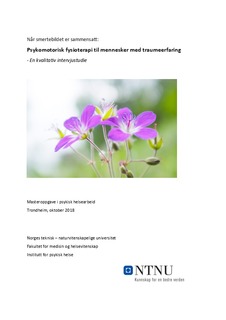| dc.contributor.advisor | Rise, Marit By | |
| dc.contributor.author | Løken, Hanne Sofie | |
| dc.date.accessioned | 2019-05-25T14:00:19Z | |
| dc.date.available | 2019-05-25T14:00:19Z | |
| dc.date.issued | 2018 | |
| dc.identifier.uri | http://hdl.handle.net/11250/2598806 | |
| dc.description.abstract | Bakgrunn og hensikt: Pasienter med sammensatte lidelser utgjør en betydelig helseutfordring i samfunnet. Det er sammenheng mellom det sammensatte symptombildet og traumeerfaring fra oppveksten. Det finnes så langt lite forskning på behandlingen denne pasientgruppen får fra Norsk psykomotorisk fysioterapi. Formålet med studien er å utforske hvordan psykomotoriske fysioterapeuter beskriver at de tilnærmer seg pasienter med traumeerfaring og sammensatte lidelser.
Design: Kvalitativt fenomenologisk hermeneutisk design.
Metode: Seks psykomotoriske fysioterapeuter deltok i individuelle semistrukturerte dybdeintervjuer. Datamaterialet ble analysert etter prinsipper om systematisk tekstkondensering.
Resultat: Psykomotorikerenes perspektiv på hvordan de mener at de bidrar i behandlingstilnærmingen, omhandlet tre erfaringsnære hovedtema: behandlingsmodaliteter (I), relasjonelle faktorer (II) og helhetlig perspektiv (III). Undertemaene var: kroppsbevissthet og kunnskapsformidling (I) , tillit/ trygghet i relasjonen og utforskende tilnærming (II) samt helhetlig forståelse og tverrfaglig samarbeid (III).
Konklusjon: Psykomotorikerene beskriver at de kan bidra med pasientens opplevelse av økt kroppsbevissthet, med trygghet og tillit i relasjonen og bidra til et helhetlig forståelsesgrunnlag i tverrfaglig sammenheng. Et vanskelig fagspråk kan angivelig være en utfordring for god kommunikasjon i tverrfaglig samarbeid.
Nøkkelord: Norsk psykomotorisk fysioterapi, allostatisk overlast, traume, sammensatte lidelser. | |
| dc.description.abstract | Background and purpose: Patients suffering from complex chronic disease is an increasing health problem in todays society. Research has shown associations between chronic pain syndromes and adverse childhood experiences. There is a lack of scientific studies assessing how these patients are treated by psychomotor physiotherapists. This study explored how psychomotor physiotherapists approach this group of patients.
Design: A qualitative phenomenological hermeneutic study design.
Method: Individual semi-structured in-depth qualitative interviews with six specialists in Norwegian psychomotor physiotherapy. Systematic text condensation as analyzing method.
Results: This research highlights the therapists perspective and what they believe to be contributing with to the treatment approach. The results points toward the following main topics: treatment methods (I) relational factors (II) and holistic perspective (III). Subgroups are: body awareness and knowledge dissemination (I), safety/ trust in the relation and an explorative approach (II) and holistic understanding and interdisciplinary collaboration (III).
Conclusion: The specialists believe that Norwegian psychomotor physiotherapy may contribute to increased body awareness, safety and trustworthiness in the patient-therapist relation and to a holistic approach towards the patients health issues in a multidisciplinary collaboration.
MeSH-terms: Norwegian psychomotor physiotherapy, allostatic overload, adverse childhood experiences, chronic pain syndrome. | |
| dc.language | nob | |
| dc.publisher | NTNU | |
| dc.title | Når smertebildet er sammensatt: Psykomotorisk fysioterapi til mennesker med traumeerfaring - En kvalitativ intervjustudie | |
| dc.type | Master thesis | |
